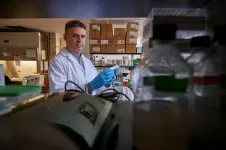UMD helps quantify how climate change has slowed global agricultural productivity growth
Collaborative research shows more severe slowdowns in warmer regions like Africa and Latin America
2021-04-01
(Press-News.org) The University of Maryland (UMD) has collaborated with Cornell University and Stanford University to quantify the man-made effects of climate change on global agricultural productivity growth for the first time. In a new study published in Nature Climate Change, researchers developed a robust model of weather effects on productivity, looking at productivity in both the presence and absence of climate change. Results indicate a 21% reduction in global agricultural productivity since 1961, which according to researchers is equivalent to completely losing the last 7 years of productivity growth. This work suggests that global agriculture is becoming more and more vulnerable to ongoing climate change effects, with warmer regions like Africa, Latin America, and the Caribbean being hit the hardest.
"Our study suggests climate and weather-related factors have already had a large impact on agricultural productivity," says Robert Chambers, professor in Agricultural and Resource Economics (AREC) at UMD and an esteemed agricultural productivity researcher. "We used the model in this paper to estimate what total factor productivity patterns would have looked like in the absence of climate change."
Total factor productivity is a calculation that is used to measure the growth of an industry, in this case agriculture. However, agriculture is a unique industry because not all the inputs that determine productivity are in the farmer's direct control, like the weather for example. Chambers and Ariel Ortiz-Bobea (lead author on this work from Cornell University and UMD AREC alum) have been pioneering new productivity calculations in agriculture to include weather data in a way that hasn't historically been addressed, bringing new accuracy to these types of climate models.
"When a farmer makes an economic decision like what to plant in June, we won't necessarily know the outcome of that decision until 6 months later," explains Chambers. "So there is a distinct break between input and output, and random events like weather can severely affect that. Productivity is essentially a calculation of your inputs compared to your outputs, and in most industries, the only way to get growth is with new inputs. Agricultural productivity measurement hasn't historically incorporated weather data, but we want to see the trends for these inputs that are out of the farmer's control."
In this case, weather data was an integral part of the model, looking at productivity in both the presence and absence of climate change. While Chambers' previous work in Science Advances gives details about the specific regional effects of climate change on U.S. agricultural productivity, this paper had a more global focus.
"Our study allows us to compare U.S. effects relative to other regions of the world," says Chambers. "The impacts for the U.S. are measurable and negative, but they appear to be much smaller than for other regions, in particular Africa."
In fact, the study finds that while global agricultural productivity growth has slowed by about 21% since 1961, areas like Africa, Latin America, and the Caribbean that are in warmer climate regions already have experienced slows in growth of 26-34%. The United States seems to be less affected, with slows in growth of approximately 5-15%.
"Some people think about climate change as a distant problem, something that should concern primarily future generations. But this overlooks the fact that humans have already changed the climate," says Ortiz-Bobea. "Overall, our study finds that anthropogenic [man-made] climate change is already having a disproportionate impact on poorer countries that depend primarily on agriculture. It appears that technological progress has not yet translated into more climate resilience."
"It's not what we can do, but it is where we are headed," adds Chambers. "This gives us an idea of trends to help see what to do in the future with new changes in the climate that are beyond what we've previously seen. We are projected to have almost 10 billion people to feed by 2050, so making sure our productivity is not just stable but growing faster than ever before is a serious concern."
INFORMATION:
This paper, entitled Anthropogenic climate change has slowed global agricultural productivity growth, is published in Nature Climate Change, DOI: 10.1038/s41558-021-01000-1.
[Attachments] See images for this press release:

ELSE PRESS RELEASES FROM THIS DATE:
2021-04-01
ITHACA, N.Y. - Despite important agricultural advancements to feed the world in the last 60 years, a Cornell-led study shows that global farming productivity is 21% lower than it could have been without climate change. This is the equivalent of losing about seven years of farm productivity increases since the 1960s.
The future potential impacts of climate change on global crop production has been quantified in many scientific reports, but the historic influence of anthropogenic climate change on the agricultural sector had yet to be modeled.
Now, a new study provides these insights: "Anthropogenic Climate Change Has Slowed Global Agricultural Productivity ...
2021-04-01
Many wildlife species are threatened by shrinking habitat. But according to new research, the potential range of African elephants could be more than five times larger than its current extent.
Due to 2,000 years of human pressure, African elephants have suffered dramatic population declines, and their range has shrunk to just 17% of what it could be, say researchers who led the new study, in Current Biology.
The dramatic reduction in range is due to the killing of elephants for their ivory and the encroachment of humans into elephant habitat. Evidence for elephants being ...
2021-04-01
Children hospitalized with breathing problems due to a common viral lung infection are likely to get sicker and remain hospitalized if they have high levels of defective copies of the virus, according to a new study by researchers at Washington University School of Medicine in St. Louis.
The findings, published April 1 in Nature Microbiology, could help doctors identify those patients at high risk of severe illness due to respiratory syncytial virus (RSV), the most common cause of pneumonia and bronchiolitis (inflammation of the small airways) in children under age 5.
"Every ...
2021-04-01
What The Study Did: This observational study examined death and hospital readmission rates of patients with COVID-19 pneumonia after being discharged to home or quarantine housing with supplemental home oxygen.
Authors: Brad Spellberg, M.D., of the Los Angeles County + University of Southern California Medical Center in Los Angeles, is the corresponding author.
To access the embargoed study: Visit our For The Media website at this link https://media.jamanetwork.com/
(doi:10.1001/jamanetworkopen.2021.3990)
Editor's Note: Please see the article for additional information, including other authors, author contributions and affiliations, conflict of interest ...
2021-04-01
What The Study Did: Researchers assessed changes in the number of views of articles published in three leading medical journals since the start of the COVID-19 pandemic.
Authors: Andrew J. Giustini, M.D., Ph.D., of the Stanford University School of Medicine in Stanford, California, is the corresponding author.
To access the embargoed study: Visit our For The Media website at this link https://media.jamanetwork.com/
(doi:10.1001/jamanetworkopen.2021.6459)
Editor's Note: Please see the article for additional information, including other authors, author contributions and affiliations, conflict ...
2021-04-01
What The Study Did: Nationally representative data were used to look at whether systolic and diastolic blood pressure levels among children and adolescents in the United States have changed during the past 20 years.
Authors: Shakia T. Hardy, Ph.D., of the University of Alabama at Birmingham, is the corresponding author.
To access the embargoed study: Visit our For The Media website at this link https://media.jamanetwork.com/
(doi:10.1001/jamanetworkopen.2021.3917)
Editor's Note: The article includes conflicts of interest and funding/support disclosures. Please see the ...
2021-04-01
BOSTON - New research reveals that when breast cancer cells spread to the brain, they must boost production of fatty acids, the building blocks of fat, in order to survive there. The work, which is published in Nature Cancer and was led by investigators at Massachusetts General Hospital (MGH) and the Koch Institute of the Massachusetts Institute of Technology (MIT), points to a potential new treatment target for shrinking brain tumors that arise secondary to breast cancer.
Therapies that target the human epidermal growth factor receptor 2 (HER2) have transformed treatment ...
2021-04-01
PHILADELPHIA - A Penn Medicine patient with a genetic form of childhood blindness gained vision, which lasted more than a year, after receiving a single injection of an experimental RNA therapy into the eye. The clinical trial was conducted by researchers at the Scheie Eye Institute in the Perelman School of Medicine at the University of Pennsylvania. Results of the case, detailed in a paper published today in Nature Medicine, show that the treatment led to marked changes at the fovea, the most important locus of human central vision.
The treatment was designed for patients diagnosed with Leber congenital amaurosis (LCA) -- an eye disorder that primarily affects the retina -- who have a CEP290 mutation, which is one of the more commonly implicated genes in patients with the ...
2021-04-01
What The Article Says: This JAMA Insights Clinical Update from the CDC's COVID-19 Response Team discusses the association of changes in COVID-19 case rates and death rates with implementation of state-issued mask mandates and allowance of any on-premises restaurant dining.
Authors: Gery P. Guy Jr, Ph.D., M.P.H., of the Centers for Disease Control and Prevention in Atlanta, is the corresponding author.
To access the embargoed study: Visit our For The Media website at this link https://media.jamanetwork.com/
(doi:10.1001/jama.2021.5455)
Editor's Note: Please see the article for additional information, including other authors, author contributions and affiliations, conflict of interest and financial disclosures, and funding ...
2021-04-01
UConn researcher Paulo Verardi, associate professor of pathobiology and veterinary science in the College of Agriculture, Health and Natural Resources, has demonstrated the success of a vaccine against Zika virus and recently published his findings in END ...
LAST 30 PRESS RELEASES:
[Press-News.org] UMD helps quantify how climate change has slowed global agricultural productivity growth
Collaborative research shows more severe slowdowns in warmer regions like Africa and Latin America


